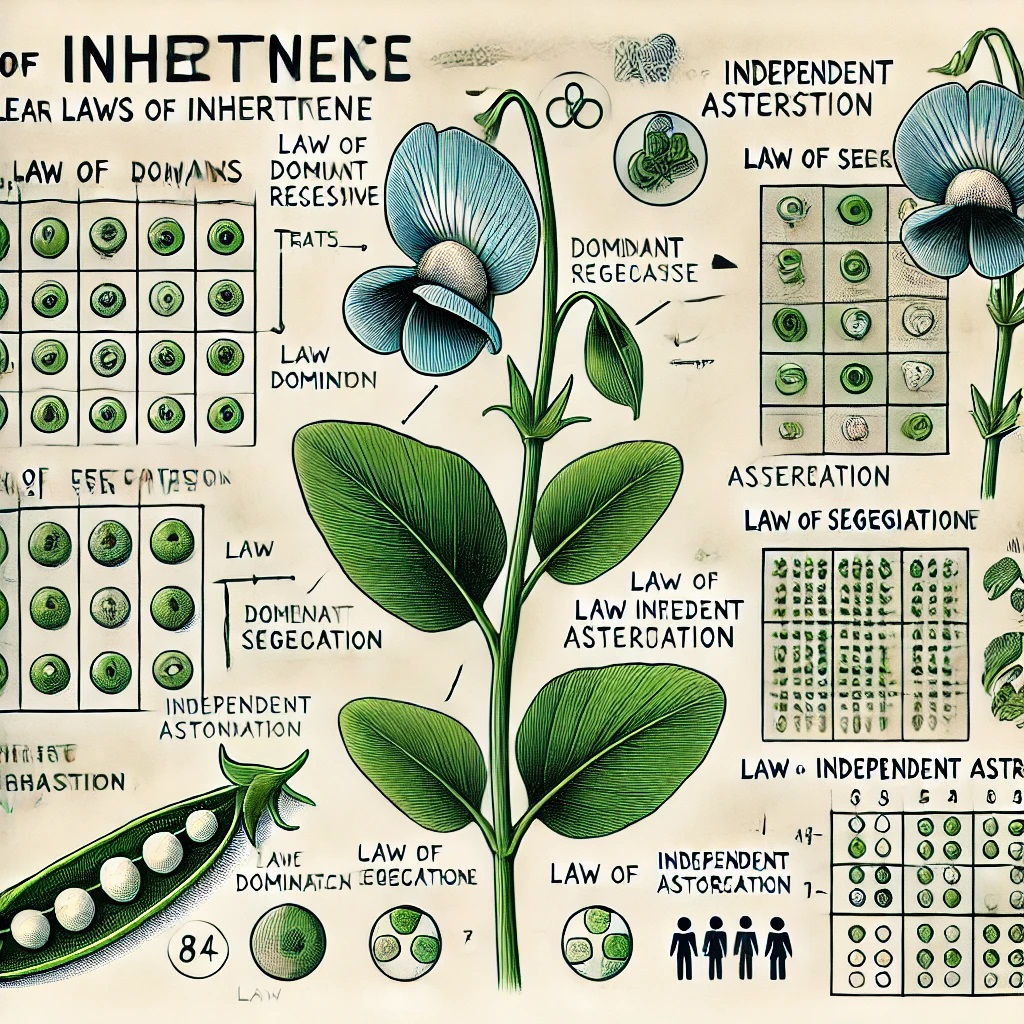Mendel’s Laws of Inheritance form the foundation of genetics, describing how traits are passed down from parents to offspring. These laws are based on the work of Gregor Johann Mendel, an Austrian monk, who conducted groundbreaking experiments on pea plants (Pisum sativum) in the mid-19th century. Mendel’s findings, published in 1865, revealed predictable patterns of inheritance, challenging the existing ideas of blended inheritance. His work laid the groundwork for modern genetics and our understanding of how characteristics are transmitted across generations.

1. Background of Mendel’s Experiment
Mendel selected pea plants for his experiments because they have several distinct characteristics, such as plant height (tall vs. short), flower color (purple vs. white), seed shape (round vs. wrinkled), and seed color (yellow vs. green). Pea plants also have the advantage of being self-pollinating but can be easily cross-pollinated by hand. Mendel performed controlled crosses between plants with different traits to observe how these traits were passed on to subsequent generations.
Mendel’s experiments focused on three main observations:
- Inheritance of Traits: Mendel observed that traits are passed from parents to offspring in specific ratios.
- Dominant and Recessive Traits: Mendel found that some traits mask others in the offspring.
- Predictable Ratios: He noticed consistent numerical ratios in the distribution of traits among offspring.
These observations led to three foundational laws of inheritance: the Law of Dominance, the Law of Segregation, and the Law of Independent Assortment.
2. Mendel’s Laws of Inheritance
Law of Dominance
The Law of Dominance states that when two organisms with contrasting traits are crossed, the trait that appears in the offspring is the dominant trait, while the trait that is hidden is recessive. In other words, the dominant allele masks the expression of the recessive allele in the heterozygous condition.
Example: In pea plants, the allele for tallness (T) is dominant, and the allele for shortness (t) is recessive. When Mendel crossed a pure tall plant (TT) with a pure short plant (tt), the offspring in the F1 generation were all tall (Tt). This shows that the tall trait is dominant, and the short trait is recessive. In this case:
- Genotype of F1: Tt (heterozygous)
- Phenotype of F1: Tall
When Mendel allowed the F1 generation to self-pollinate, the F2 generation exhibited both tall and short plants in a 3:1 ratio. This observation led to the conclusion that each plant carries two “factors” (now known as alleles) for each trait, and that one factor can mask the expression of the other.
Law of Segregation
The Law of Segregation states that during the formation of gametes (egg and sperm), the two alleles for each trait separate or “segregate” so that each gamete receives only one allele from each pair. This ensures that offspring inherit one allele from each parent.
Example: Returning to the tall and short plants, the F1 generation (Tt) carries one allele for tallness and one for shortness. When these plants form gametes, the alleles segregate, so each gamete carries either the T or the t allele. When these gametes combine during fertilization, they create four possible combinations in the F2 generation (TT, Tt, Tt, tt), resulting in a 3:1 ratio of tall to short plants in terms of phenotype.
This law can be represented by the Punnett square for an F1 cross (Tt x Tt):
| T | t | |
|---|---|---|
| T | TT | Tt |
| t | Tt | tt |
The resulting genotypic ratio is 1:2:1 (TT:Tt), and the phenotypic ratio is 3:1 (Tall).
Law of Independent Assortment
The Law of Independent Assortment states that alleles of different genes assort independently of each other during gamete formation, provided that the genes are located on different chromosomes. This means that the inheritance of one trait is independent of the inheritance of another trait.
Example: Mendel also experimented with plants that had two traits, such as seed color and seed shape. He crossed plants with round yellow seeds (RRYY) with plants that had wrinkled green seeds (rryy). The F1 generation displayed round yellow seeds (RrYy), showing the dominant traits. When these plants were allowed to self-pollinate, the F2 generation displayed a variety of combinations (round yellow, round green, wrinkled yellow, and wrinkled green) in a 9:3:3:1 phenotypic ratio. This confirmed that the inheritance of seed shape is independent of seed color.
This law is best visualized using a dihybrid cross Punnett square:
| RY | Ry | rY | ry | |
|---|---|---|---|---|
| RY | RRYy | RRYy | RrYY | RrYy |
| Ry | RRYy | Rryy | RrYy | RrYy |
| rY | RrYy | RrYy | rrYY | rrYy |
| ry | RrYy | RrYy | rrYy | rryy |
This pattern confirms that each gene pair separates independently during gamete formation.
3. Mendel’s Experimental Methods and Results
Monohybrid Cross (Single Trait)
In a monohybrid cross, Mendel focused on one trait at a time. For example, he crossed tall and short pea plants, resulting in tall plants in the F1 generation. When the F1 plants self-pollinated, the F2 generation showed a 3:1 ratio of tall to short plants, demonstrating the principles of dominance and segregation.
Dihybrid Cross (Two Traits)
In a dihybrid cross, Mendel studied two traits at once, such as seed shape and color. Crossing plants with round yellow seeds and wrinkled green seeds, he observed a 9:3:3:1 phenotypic ratio in the F2 generation. This outcome provided evidence for the Law of Independent Assortment.
4. Exceptions to Mendel’s Laws
While Mendel’s laws form the foundation of genetics, there are some exceptions due to more complex inheritance patterns:
- Incomplete Dominance: In this case, neither allele is completely dominant, resulting in a blend of traits. For example, in snapdragons, crossing red and white flowers results in pink offspring.
- Codominance: Both alleles express themselves equally in the phenotype. An example is the AB blood type in humans, where both A and B alleles are equally expressed.
- Multiple Alleles: Some traits are governed by more than two alleles, such as the ABO blood group system in humans, which involves three alleles (A, B, and O).
- Linked Genes: Genes located close together on the same chromosome tend to be inherited together, violating the Law of Independent Assortment.
- Polygenic Inheritance: Traits like skin color, height, and eye color in humans are controlled by multiple genes, resulting in a wide range of phenotypes.
- Pleiotropy: A single gene can affect multiple traits. For example, the gene responsible for sickle cell anemia also affects malaria resistance.
5. Modern Applications of Mendel’s Laws
Mendel’s Laws have profound applications in modern genetics:
- Plant and Animal Breeding: Knowledge of inheritance allows breeders to select desirable traits, increasing crop yields, disease resistance, and animal productivity.
- Medical Genetics: Mendelian inheritance patterns help genetic counselors predict the likelihood of genetic disorders in offspring.
- Genetic Engineering: By understanding gene function and inheritance, scientists can manipulate genes to produce genetically modified organisms (GMOs) for agriculture and medicine.
10 Questions with Answers, along with Explanations
1. What organism did Gregor Mendel use for his experiments on inheritance?
Answer: Gregor Mendel used pea plants (Pisum sativum) for his experiments.
Explanation: Mendel chose pea plants because they have distinct, easily observable traits (such as flower color, seed shape, and plant height) and reproduce quickly. Additionally, they can self-pollinate and cross-pollinate, which allowed Mendel to control breeding and observe inheritance patterns across generations.
2. What is the Law of Dominance in Mendel’s inheritance laws?
Answer: The Law of Dominance states that in a pair of contrasting traits, one trait (dominant) will mask the appearance of the other trait (recessive) in the offspring if they are heterozygous.
Explanation: For example, in pea plants, the allele for tallness (T) is dominant over the allele for shortness (t). So, a plant with the genotype Tt will be tall, as the dominant trait (T) masks the recessive trait (t).
3. What is the Law of Segregation?
Answer: The Law of Segregation states that during gamete formation, the two alleles for each trait separate so that each gamete receives only one allele.
Explanation: This means that for a plant with genotype Tt, the T and t alleles will segregate into separate gametes during meiosis. This is why, during fertilization, offspring inherit one allele from each parent, ensuring genetic diversity.
4. What is the Law of Independent Assortment?
Answer: The Law of Independent Assortment states that genes for different traits segregate independently during gamete formation, as long as the genes are on different chromosomes.
Explanation: For example, if a plant has alleles for seed color (yellow or green) and seed shape (round or wrinkled), these traits assort independently. Thus, the inheritance of seed color does not affect the inheritance of seed shape.
5. What is a Punnett square, and why is it useful?
Answer: A Punnett square is a diagram that helps predict the genetic makeup and phenotypes of offspring from a genetic cross.
Explanation: The Punnett square organizes parental gametes on two axes, allowing us to calculate the probability of different allele combinations in offspring. It’s especially useful in visualizing and predicting genotypic and phenotypic ratios.
6. What is the difference between genotype and phenotype?
Answer: Genotype refers to the genetic makeup of an organism (e.g., TT, Tt, or tt), while phenotype is the observable characteristic or trait (e.g., tall or short).
Explanation: Genotype determines the genetic potential for traits, while phenotype represents how these traits physically express in the organism. For example, both TT and Tt genotypes result in a tall phenotype due to the dominance of the tall allele (T).
7. What is incomplete dominance? How does it differ from Mendel’s laws?
Answer: Incomplete dominance occurs when the heterozygous phenotype is a blend of the two homozygous phenotypes, rather than one being dominant over the other.
Explanation: For instance, in snapdragon flowers, crossing red (RR) and white (rr) flowers results in pink flowers (Rr), an intermediate phenotype. This differs from Mendel’s Law of Dominance, where one trait completely masks the other in the heterozygous condition.
8. What is a dihybrid cross, and what ratio did Mendel observe in the F2 generation?
Answer: A dihybrid cross examines the inheritance of two traits simultaneously. Mendel observed a 9:3:3:1 ratio of phenotypes in the F2 generation of a dihybrid cross.
Explanation: For example, Mendel crossed plants with round yellow seeds and wrinkled green seeds, and in the F2 generation, he found nine round yellow, three round green, three wrinkled yellow, and one wrinkled green offspring. This ratio demonstrates the Law of Independent Assortment.
9. Why were Mendel’s results initially ignored by the scientific community?
Answer: Mendel’s work was initially ignored because his mathematical approach to biology was unconventional for that time, and scientists did not fully understand the importance of his findings.
Explanation: At the time, scientists believed in the “blending theory” of inheritance, which contradicted Mendel’s findings. It was not until the early 20th century, when his work was rediscovered and understood within the context of chromosome behavior during cell division, that Mendel’s principles were appreciated.
10. How did Mendel’s work contribute to modern genetics?
Answer: Mendel’s work provided the foundation for modern genetics by establishing key principles of inheritance that are still used to understand genetic traits.
Explanation: Mendel’s principles, including the concepts of dominance, segregation, and independent assortment, remain core to genetics. These laws are crucial for understanding genetic inheritance, and they have applications in fields such as genetic engineering, disease research, and breeding programs.






